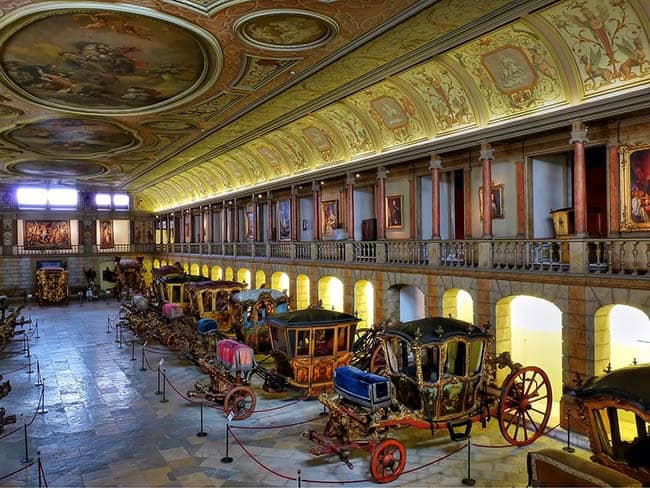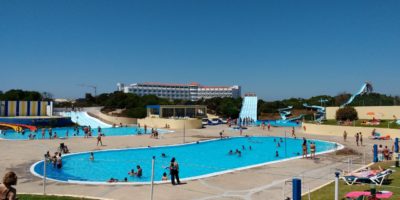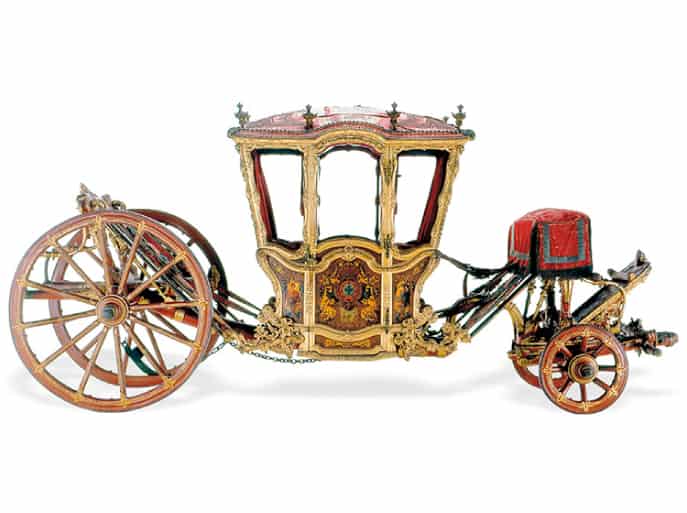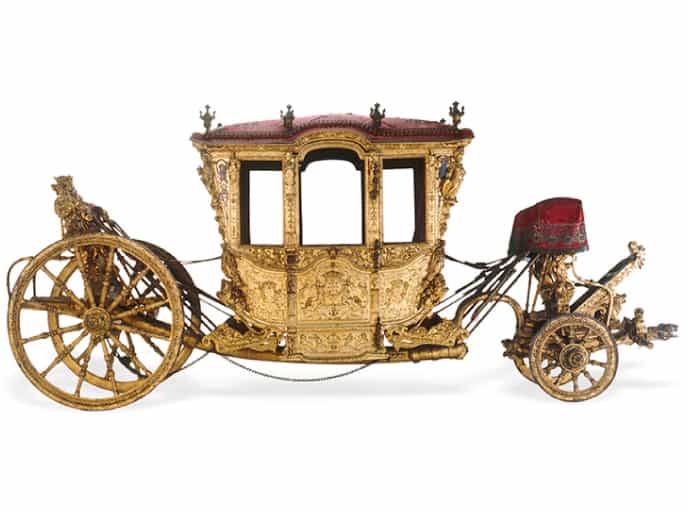4 Reasons to Visit Lisbon’s Coach Museum
The National Carriage Museum (Museu dos Сoches) is one of the most popular museums in Lisbon, with about 200,000 visitors per year…
How to find the Museum
Address: Avenida da Índia 136, 1300-300 Lisboa
If you are a fan of rich European history you need to visit the Museum of Coaches. Its mesmerizing richness will leave you breathless. All the ornaments and carvings of the coaches will take you to the times of empire with the ghosts of beautiful kings and queens.
In 2015, the National Museum of carriages was divided into two parts: the old building – the Royal Stables (Picadeiro Real), and the new, where the main part of the exhibits was later transferred. Also, work was carried out on the restoration of carriages, including those that had not previously been exhibited.
In the new modern building of the museum, as conceived by the architects, all the attention of visitors is concentrated on the carriages and the magnificent interiors of the old museum will not distract from the exhibits. Access to the old building of the royal stables remained available with a separate ticket.
The coach museum was founded by Queen Amelia in 1905. Located in the building of a former riding school with the royal palace, now the residence of the President of Portugal. Amelia wanted to keep there a set of carriages belonging to the royal family. For a long royal history, they accumulated quite a lot, so that the collection turned out to be large and very impressive.
The museum contains carriages from almost all of Europe (Portugal, France, Austria, Italy, Spain) and describes in detail the process of their creation.
1) Visit because it is the Best in the World
The National Museum of carriages in the capital of Portugal is considered the best in the world. Its main collection includes so many rare and interesting carriages that such a seemingly not too serious museum has actually remained for many years one of the most visited in Lisbon.
And indeed, the place is very interesting. Not too formal, not at all academic, fun, bright, suitable for children and adults, and certainly not boring. Come with daughters 6-7 years old, at the age when children love the Cinderella fairy tale, and you will light up their day.
The main (but not the only) part of the museum is dedicated to the crews. The oldest dates from the end of the 16th – the beginning of the 17th century, the newest – the beginning of the 20th. There are magnificent baroque carriages, all in golden curlicues. There are ceremonial carriages suitable for ladies in crinolines. Then the fashion changed, and light carriages with leather tops came to the place of heavy gilded carriages – they are in the collection too. There are convertibles, single strollers and much more.
Most of the carriages belonged to the Portuguese royal family, but there are exceptions. There are carriages of embassies and there are carriages that once belonged to the Pope – the head of the Catholic Church. Also in the collection, there are many old bicycles.
The second part of the collection is accessories related to transport: a collection of horse harnesses, of the most diverse, old parts for old bicycles, standards for royal trips and much more. There is also a set of costumes – mostly forms: for grooms, etc.
2) Visit to indulge in Architecture
The museum is located in a wonderful old building – Picadeiro, i.e. equestrian arena. It was built in 1786 by the famous Italian architect Giacomo Azzolini and is very beautifully decorated: the walls and ceiling are covered with paintings, some of the walls are covered with famous Portuguese tiles (azulejo) – this is a very elegant old building.
In general, it turned the museum into a very interesting place. It has a mass of interesting and unusual objects and in a very beautiful and original building. The exhibition in this museum is completely unlike anything. Be sure to go here if you have such an opportunity.
3) Visit to indulge in History
The history of the museum began on May 23, 1905, with the light hand of the last Portuguese Queen Donna Amelia. The coach museum was opened in the royal arena (Picadeiro Real), built in the middle of the 18th century. The building was standing within just a few years, but the interior decoration lasted 40 years.
The main hall-arena fits 29 carriages. The city authorities have decided that it would be a big waste if that heritage disappeared so they built a modern building for the museum of carriages right across the road.
If earlier travelers had a problem finding the entrance to the carriage museum, now you definitely won’t miss it.
The huge construction of glass and concrete is located almost on the banks of the Tagus, next to the station of the suburban trains in Belém. There were many disputes, rallies and scandals around this concrete “box” that is worth 40 million euros.
At first, us Lisbonites were also skeptical of this building. However, after the construction was completed, the building turned out to be quite harmonious.
Inside there is a lot of light and space. The new building of the national coach museum balances with the Belem area very well.
The Brazilian architect Paulo Mendez da Rocha, who at 78 years old won the Pritzker prize, was the architect of the new coach museum building in Lisbon. He was convinced that technology is an integral part of any project and not just a tool for its implementation. All of his projects are brutal and technological.
The main materials are concrete and the shape is parallelepiped. The ribbon glazing of the lower tier of the building creates the feeling that it is one with the surrounding space.
In 2015,110 years after the museum was founded, it opened its doors in a new guise. In the museum space is not just a lot, but a spacious and gracious “fairytale” interpretation. If in the old building there was a feeling that you were let into an “old garage”, in the new building people are mesmerized when they walk into the museum for the first time.
Many presented vehicles were left as a gift to the Portuguese monarchs from the Spaniards, Austrians, Danes, French, and Italians.
The oldest exhibit dates back to the 16th century, and then all the magnificence is presented in chronological order so that we can follow the technical evolution of carriages as well as the changing tastes of nobles and clergy with a clear example.
4) Visit to see the beautiful Coaches
Filip II carriage
Carriage Filip II (Portugal) or Filip III (Spain) – the oldest carriage in the exhibition, and most likely the most uncomfortable of them all. Filip II visited Lisbon in 1619, two years before his death, and he traveled all the way from Madrid in this carriage. Heavy curtains served as the only protection from wind and cold.
Another feature of the design of this carriage is the hole in the seat. This way there was no reason for the carriage to stop when the monarch needed to relieve himself…
Carriage of Maria Francisco de Saboia
Echoing the antiquity, the carriage belonged to the cousin of the French king Louis XIV. Maria Francisco de Saboia (Mademoiselle d ’Aumale) was the wife of two brothers: the first husband was King Don Afonso VI (he asked for a divorce), the second – his brother King Don Pedro II.
Carriage of the bride Maria Anna
This golden carriage will surely catch your attention. It was made by order of the Austrian emperor Jose I in 1708, for the wedding of his sister Donna Maria Anna of Austria with the Portuguese king João V.
The letter M, which is engraved on a carriage, is the monogram of Donna Maria Anna. The official name is “Donna Maria Anne of Austria Carriage”.
Royal Carriage
This is the carriage of the French masters of the XVIII century. It is worth paying attention to the sculptures on the roof of the carriage – the angels crowning the dragon. The dragon is the symbol of the royal house of Braganza.
The Oceans Carriage
This is without a doubt the jewel of the collection. The carriage shouts for the show, surprising with its luxury and richness of decoration. The triumphal carriage was made in Rome in 1716, especially for the visit of the Portuguese embassy to the Vatican.
The delegation was sent during the heyday of the Portuguese empire when the golden rain pouring out of Brazil made Juan V the richest monarch in Europe.
The carriage is decorated with gilded baroque figures – an allegory on the subject of Portuguese maritime discoveries and the sea connection of two oceans, the Indian and the Atlantic.
Recently, this amazing exhibit was restored using original materials, fabrics, and embroidery. This truly titanic work is devoted to the book “The Carriage of the Oceans.”
Next to this dazzling carriage, there are two more valuable copies, which also were, sent to the Vatican. Carriage Coronation of Lisbon.
Carriage Coronation of Lisbon
In the center of the sculpture is a girl – this is Lisbon. Perhaps you have a question, why the capital is represented in the form of a woman. I will not torture you with guesses, in Portuguese Lisboa is feminine, so Lisbon is actually a young lady.
The third carriage from this tuple is named Ambassador, the sculptural composition of this carriage is an allegory on the theme of Navigation and conquests of the Portuguese. It is decorated with lions, dragons, sea monsters, horses and many other sculptures.
The Table Carriage
With this name, the carriage is obliged to the round table installed inside. The second name – “Princess Carriage Exchange” received because of the ceremony, which occurred in 1729 on the border of Portugal and Spain.
Then the Portuguese princess Maria Barbara (daughter of Don João V), was exchanged for the Spanish princess Mariana Vitoria, the daughter of Philip V. The princesses set off to marry the future kings of Spain and Portugal, respectively.
The carriage is completely closed but it has two glazed windows. Internal upholstery is made of crimson velvet, the ceiling is decorated with golden wicker fringe.
In the next room, there are a number of clergy carriages and carriages used in religious processions.
Opening hours of the museum
Opening hours: Tue-Sun, 10:00 – 18:00, last entrance at 17:30
Costs: a regular ticket to the museum – 8 €; old building – 4 €; combined ticket (museum + old building) – 10 €; 50% discount – 65+ years old, teenagers 15-18 years old when visiting with their parents.
Planning a trip to Paris ? Get ready !
These are Amazon’s best-selling travel products that you may need for coming to Paris.
Bookstore
- The best travel book : Rick Steves – Paris 2023 – Learn more here
- Fodor’s Paris 2024 – Learn more here
Travel Gear
- Venture Pal Lightweight Backpack – Learn more here
- Samsonite Winfield 2 28″ Luggage – Learn more here
- Swig Savvy’s Stainless Steel Insulated Water Bottle – Learn more here
Check Amazon’s best-seller list for the most popular travel accessories. We sometimes read this list just to find out what new travel products people are buying.






















